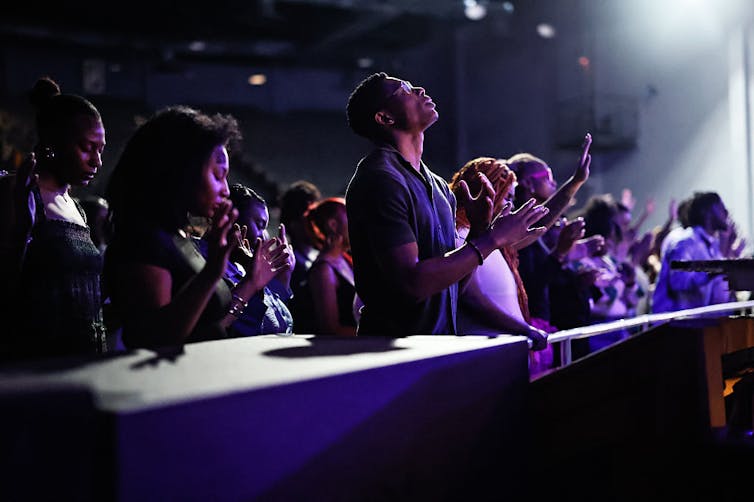Most colleges score low on helping students of all faiths – or none – develop a sense of belonging. Faculty can help change that
- Written by Matthew J. Mayhew, Professor of Higher Education, The Ohio State University
 Students don't need to be protected from others' views, but they can benefit from support to keep those conversations respectful.PIKSEL/iStock via Getty Images Plus
Students don't need to be protected from others' views, but they can benefit from support to keep those conversations respectful.PIKSEL/iStock via Getty Images PlusWhat helps students from all walks of life have a good college experience?
Beyond all the concrete things schools can offer – academics, research opportunities, sports, dining halls – is something both basic and hard to define: a sense of belonging.
Factors such as race and gender can influence how at home a student feels on campus, contributing to their overall well-being. But my research highlights the role of religion and spirituality, too: how support for students’ worldviews – whether they’re deeply religious, atheist or somewhere in between – shapes their campus experience.
My recent scholarship with fellow higher education professor Musbah Shaheen argues that a sense of belonging arises mainly from meaningful relationships and conversations about those topics, not from simply having religious clubs and organizations on campus.
With that in mind, we believe universities can move beyond tolerance toward real appreciation for all students, including religious minorities.
Foundational role of relationships
This recent work builds on results from the Interfaith Diversity Experiences and Attitudes Longitudinal Survey, or IDEALS. In 2014, higher education researcher Alyssa N. Rockenbach and I designed the project in partnership with Interfaith America, a nonprofit that encourages interfaith dialogue on campus. Running from 2015 to 2019, it surveyed 3,486 students across 122 campuses to understand the ways colleges could support students’ well-being when it comes to their worldviews, religious identities and spiritual beliefs.
A main theme emerged in students’ responses: Feeling cared about, accepted and valued on campus was rooted in relationships. But faculty and staff also had an important role to play in modeling respectful relationships and in helping students engage respectively with each other.
 Jackson State University students worship during the Tigerville Gospel Explosion on April 13, 2025, in Jackson, Miss.Aron Smith/Jackson State University via Getty Images
Jackson State University students worship during the Tigerville Gospel Explosion on April 13, 2025, in Jackson, Miss.Aron Smith/Jackson State University via Getty ImagesFindings from the study also showed that campuses can help foster student friendships across religions by creating opportunities for students to engage with each other authentically. They can try to make sure campus conversations about religion and spirituality are built on trust, not proselytizing or coercion. They can offer opportunities for students from different religious backgrounds to participate in service-learning experiences, leadership opportunities and interfaith programs, to name a few.
Respectful relationships are especially important for religious minorities’ sense of belonging. A campus’s climate is often shaped by Christian heritage in ways many students may not even notice: chapels, sometimes repurposed as classroom space; dining halls that don’t offer halal or kosher meals; and academic calendars that prioritize certain religious holidays over others.
Apart from addressing these issues head-on, there are other ways to help offset these dynamics. In the IDEALS study, students who reported having supportive spaces for challenging but respectful dialogues – where they could share perspectives without feeling coerced or harmed – with peers who hold differing worldviews felt a greater sense of belonging.
The answer is not to avoid tough conversations. Instead, it is to ensure they are guided and productive. In this sense, strong academic engagement matters: involving faculty both in and out of the classroom, as one means of helping students engage with one another respectfully.
Academic support
Thanks to the IDEALS survey, we had a sense of what matters to students in making their worldview feel respected on campus. But how are campuses actually doing at implementing those practices?
To find out, Rockenbach and I then designed the Institutional Norms Supporting Pluralism and Inclusive Religious Engagement Study, or INSPIRES. This ongoing project is a multiyear exploration into the factors institutions have in place to support the well-being of students with a wide range of beliefs.
 Jewish students and allies hold a Shabbat and a prayer in solidarity with the pro-Palestinian students encampment at George Washington University in Washington, D.C., on April 26, 2024.Celal Gunes/Anadolu via Getty Images
Jewish students and allies hold a Shabbat and a prayer in solidarity with the pro-Palestinian students encampment at George Washington University in Washington, D.C., on April 26, 2024.Celal Gunes/Anadolu via Getty ImagesThe sample included data from 318 colleges and universities. Thirty-one percent were public, while 69% were private. Any university can sign up for the assessment, free of cost, so 174 of these schools have participated multiple times to understand how their campus’s climate is changing – whether it’s becoming more welcoming, and for whom.
Our team used student responses to the IDEALS surveys to develop scales, measuring how welcoming campuses are for students from diverse spiritual backgrounds. We then rated schools from 1 to 5 – the highest rating – on several different areas, such as religious accommodations and efforts to combat hate and intolerance.
One of the most important categories is academic engagement – specifically, how institutions formalize practices designed to foster two things. The first is interfaith literacy: knowledge and understanding of diverse religious traditions. The second is dialogue: structured opportunities for interaction among people of different religious, spiritual and secular beliefs.
The data shows that most schools have lots of room for improvement when it comes to academic engagement about religion. Using the 1-5 scale, 19% of institutions scored a 1, and 33% of schools scored just a 2. Another 30% scored a 3. Seventeen percent scored a 4 – and only two out of the 318 received a 5.
More than 52% of institutions are in the lowest two levels, highlighting the lack of campuswide academic initiatives that foster belonging.
 A student wears a graduation cap with a verse from the Quran written on it at Columbia University in New York City on May 21, 2025.Jeenah Moon/Pool/AFP via Getty Images
A student wears a graduation cap with a verse from the Quran written on it at Columbia University in New York City on May 21, 2025.Jeenah Moon/Pool/AFP via Getty Images5-star standard
The five-star standard includes practices that foster safe, guided interactions among people who hold different worldviews.
In part, that means embedding worldview diversity in the curriculum. Higher-scoring schools offer majors or minors in religious studies. What’s more, they offer courses in many departments that address various spiritual, religious and secular perspectives. Where appropriate, faculty include topics related to students’ identities and worldviews to prompt discussion.
For religious minorities, in particular, seeing their identities reflected in academic offerings helps them feel seen and signals that their traditions are intellectually important.
Five-star schools also make space for academic conversations about religion with faculty outside the classroom. According to IDEALS, students who discussed topics related to personal values or beliefs with faculty outside of class felt a stronger sense of belonging.
Classrooms, office hours and academic group work can be spaces for what we call “provocative encounters,” where students may be uncomfortable being exposed to different perspectives but do not feel coerced or harmed. This turns topics that could leave students feeling marginalized, silenced or preached to into opportunities for meaningful connection.
Students’ sense of religious and spiritual belonging comes from everyday relationships – authentic connections and conversations that faculty and staff can help foster. I believe universities can create an environment where all students, including religious minorities, feel seen, accepted and appreciated.
Matthew J. Mayhew receives funding from the Templeton Religions Trust, the Arthur Vining Davis Foundations, the Pew Charitable Trusts, the Educational Credit Management Corporation (ECMC) Foundation, the National Science Foundation, the Alfred P. Sloan Foundation, the Merrifield Family Trust, the Andrew W. Mellon Foundation, the Fetzer Institute, the Ewing Marion Kauffman Foundation, the Merrifield Family Trust, and the United States Department of Education.
Authors: Matthew J. Mayhew, Professor of Higher Education, The Ohio State University

